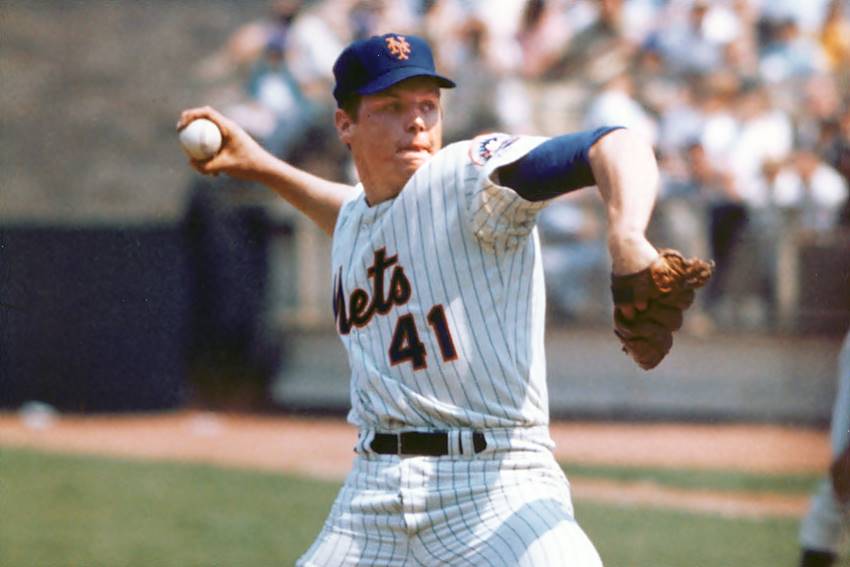Interview: Ron Swoboda reflects on Mets legend Tom Seaver and his greatness
One of the very best pitchers in Major League Baseball history is gone.
Hall of Fame pitcher Tom Seaver, who starred as the New York Mets won the 1969 World Series, has died at the age of 75.
The Baseball Hall of Fame announced Wednesday that Seaver died reportedly from complications of Lewy body dementia and COVID-19.
A 12-time All-Star, Seaver pitched 20 seasons and won 311 games. He had 3,640 strikeouts and won three Cy Young awards, pitching until the age of 41. Seaver threw 61 shutouts and had a no-hitter. Seaver was elected to the Baseball Hall of Fame in 1992 with 98.8 percent of the vote.
While everyone remembers the monumental upset win by the Mets over the Baltimore Orioles in the 1969 World Series, many likely do not remember how it happened.
How big of an upset was it?
The Orioles were heavily favored, having won 109 games in the regular season, running away to win the American League East. The Mets were a 100-to-1 underdog entering the season.
In the American League Championship Series, the Orioles swept the Minnesota Twins, running right through them and looked the part of an unstoppable juggernaut.
Of course, the Mets were a very good team, having won 100 games with a superb pitching staff to win the National League East. In the NLCS, New York swept through Atlanta.
Known as “Tom Terrific” and later as “The Franchise,” Seaver led the pitching staff, going 25-7 with a 2.21 ERA to win the Cy Young Award in the 1969 season.
In the World Series, Seaver and the Mets actually lost the opening game 4-1 at Memorial Stadium as Seaver gave up all four runs on six hits in five innings pitched as Don Buford doubled and homered for Baltimore.
After the Mets rebounded to win Games 2 and 3, Seaver took to the mound in Game 4 at Shea Stadium and he redeemed himself in a huge way.
Seaver pitched a complete game as the Mets won 2-1 in 10 innings. He allowed just the one run on six hits, striking out six. New York scored the winning run on a throwing error by Pete Richert, setting the stage for game five when the Mets won 5-3 to complete the improbable victory.
The accomplishment was deemed to important that the New York team earned the nickname “Miracle Mets.”
In the ninth inning of Game 4, the Orioles had a chance to take the lead and possibly win the game but Ron Swoboda made a fantastic catch, laying out to make the play on a line drive off the bat of Brooks Robinson.
The Orioles scored the tying run as Frank Robinson tagged up from third on the play, but there was also a runner at first with just one out who could have easily scored if Swoboda had not made the catch.
A Baltimore victory would have evened the series 2-2.
“We may be having a different discussion if I don’t make the catch,” said Swoboda, who has spent most of the last 40 years in New Orleans. “It was do or die. Fortunately, the ball stuck in my glove. If the ball Brooks hits gets by me, it may have lost the game for us.
“Tom had been incredible all season long. You didn’t have to make many great plays when he pitched. I sort of got even by making the catch. I will always be grateful.”
Swoboda had an outstanding World Series, batting .400 (6-for-15) with a double and an RBI, including a 3-for-4 performance in Game 4. He was Seaver’s teammate with the Mets from 1967-70. It was sad for Swoboda to watch the decline of his former teammate recently.
“He was going through dementia and we always heard it was part of Lyme disease,” Swoboda said. “We heard it was increasing and a little while back, he stepped away from his public life. It wasn’t going to get any better. It is unfortunate and it is sad.”
Swoboda remembers when Seaver got called up to New York for the first time in 1967.
“I was there when he came to the Mets to start that season,” Swoboda said. “There are not many guys that come up and right out of the box, look like a Hall of Fame guy. He was great from the start. He conducted himself the way you were supposed to. He had confidence. He had done boot camp in the Marine reserves. He knew what he wanted to do out there. If you got him three runs, you had a real good chance to win.”
The Miracle Mets were the sum of their parts with one exception.
“We were a team without superstars and Seaver was that superstar,” Swoboda said. “His whole demeanor was solid and focused. He did it the way you were supposed to do it, every aspect of it. You played behind him, you witnessed greatness on a regular basis.”
Nowadays, pitchers most often salute players who make great plays behind them by tipping the cap or pointing at the fielder making the great play. Did Seaver salute Swoboda in any way after the catch in Game 4?
“Things were so hectic then,” Swoboda said. “I don’t remember his saluting me or clapping when I made the catch,” Swoboda said. “I should have caught a ball to right field in Game 1 that I let get out of the ballpark from Buford. I felt like I owed him one.”
After spending nine years in Major League Baseball, Swoboda knows who the hardest pitcher he faced was.
“I would put Bob Gibson as the toughest guy I ever faced,” Swoboda said. “I never faced Seaver as his teammate, other than once in spring training and I’m glad I didn’t. He came so close to throwing no-hitters with the Mets but he never did. He finally did with the Reds later in his career.”
While Gibson was great, Swoboda puts Seaver in another category.
“Tom was simply the best pitcher of my era in baseball,” Swoboda said. “We got him in the lottery and did it ever pay off. We never win a World Series title without Tom Seaver. He was a great guy and his greatness as a pitcher will live forever. It was an honor playing with him, playing behind him. Our 1969 team will always walk together, forever. Just don’t tell Gibson I said it. He might knock me down with a heater.”

I was fortunate to be the play-by-play announcer for the New Orleans Zephyrs, who hosted the 1999 Triple-A All Star Game at Zephyr Field. From 1995-2019, Swoboda was the color analyst on Zephyrs games on radio and television. It was a time we both enjoyed immensely, due to our mutual love of the game. We remain very good friends today.
At that All-Star game in Metairie was Seaver, who was there for Major League Baseball.
While I am a lifelong St. Louis Cardinals fan and have never been star-struck, covering many of the top professional athletes in many sports, I was absolutely impressed, perhaps star-struck, by seeing and meeting Seaver. He was terrific. His team was a miracle. Our mutual friend, his former Mets teammate, was a blessing to both of us, to Tom on the field and to me off the field.
The Miracle, along with Seaver and Swoboda will live on for many, many years to come.
- < PREV Morant's NBA Rookie of the Year win over Zion is the right call
- NEXT > First Tee - Greater New Orleans hosts inaugural 100 Hole Golf Marathon to support local youth and teens
Ken Trahan
CEO/Owner
Born and raised in the New Orleans area, CCSE CEO Ken Trahan has been a sports media fixture in the community for nearly four decades. Ken started NewOrleans.com/Sports with Bill Hammack and Don Jones in 2008. In 2011, the site became SportsNOLA.com. On August 1, 2017, Ken helped launch CrescentCitySports.com. Having accumulated national awards/recognition (National Sports Media Association, National Football…





